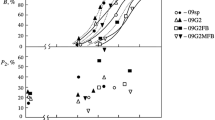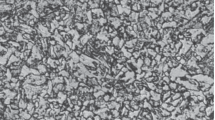Conclusions
-
1.
High-temperature brittleness of steels is observed in the temperature range 0.90–0.99T melt and is characterized by a narrow temperature range (generally not exceeding 10°C) in which the ductile and strength parameters are not affected by the deformation rate. In this range the steels fracture by a grain-boundary mechanism with the formation of a characteristic molten relief.
-
2.
The temperature of the ductile-brittle, transformationT d/b (the temperature of zero ductility) is most affected by C. S, P, and B; an increase in their content diminishesT d/b. The addition of manganese and the treatment of the melt with REM and AEM weaken the effect of sulfur and increase the temperatureT d/b by 10–100°C.
-
3.
Most investigators attribute the appearance of the ductile-brittle transformation at near-solidus temperatures to the early melting of grain boundaries. The problems of the mechanism of formation and the chemical composition and role of the liquid phase in the evolution of grain-boundary fracture requires additional theoretical and experimental studies.
-
4.
The available data (the “abrupt” behavior of the curves of ductile-brittle transformation, the experimentally determined liquid layers atT=T d/b) show that the temperature of grain-boundary melting can be determined using the method of high-temperature mechanical tests and can be understood as the temperature of the ductile-brittle transformationT d/b.
-
5.
The temperature of grain-boundary melting in tool steels R6M5 and R18 coincides with the temperature ranges of heating for quenching recommended by GOST 19265-73, which should be taken into account in practical heat treatment because the melting of grain boundaries can be a cause of instability of the mechanical properties of small-size tools.
Similar content being viewed by others
References
B. B. Gulyaev,The Theory of Casting Processes [in Russian], Mashinostroenie, Leningrad (1976).
N. N. Prokhorov,Hot Cracks in Welding [in Russian], Mashgiz, Moscow (1952).
R. M. Nikonova and V. V. Zabil'skii,Ductile-Brittle Transformation in Steels at Near-Solidus Temperatures (A Review). Dep. VINITI 01.07.98. No. 2028-V98 [in Russian], Moscow (1998).
V. V. Zabil'skii and V. I. Lebedev, “Formation of transverse and net surface cracks and high-temperature embrittlement of steels in continuous casting,” in:Chern. Met., Byul. NTI, Issue 2 [in Russian] (1991), pp. 13–29.
J. K. Brimacombe, F. Wenberg, and E. F. Hambolt, “Formation of longitudinal, midface cracks, in continuously-cast slabs”Metallurg. Trans.,10B(6), 279–292 (1979).
J. Klibe and I. Schindler, “Some theoretical, aspects of plastic deformation in semi-solid state,”Metalurgija,33(3), 105–108 (1994).
G. I. Eskin, “Fourth international conference on deformation of alloys and composites in a solid-liquid state,”Tekhnol. Legk. Splavov, No. 5, 66–67, 99 (1996).
I. I. Novikov,Hot Brittleness of Nonferrous Metals and Alloys [in Russian], Nauka, Moscow (1966).
R. M. Nikonova,Effect of Various Factors on the High-Temperature Brittleness of Steels, Author's Abstract of Candidate's Thesis [in Russian], Izhevsk (1997).
F. Weinberg, “The ductility of continuously-cast steel near the melting point-hot tearing,”Metallurg. Trans.,10B(6), 219–227 (1979).
K. Kabazu and Yu. Kitagawa, “Mechanical characteristics of steel at high temperature,”J. Jpn. Soc. Technol. Duct.,22(247), 774–778 (1981).
H. Sudzuki, S. Nisimura, and S. Yamaguti, “Characteristic of high-temperature embrittlement of various steels with hardening structure,”Tetsu to Hagane,3, 56–64 (1980).
Yu. Ya. Shok,Mechanical Properties of Steel at Near-Solidus Temperatures, Preprint [in Russian]. IPL Akad. Nauk USSR, Kiev (1983).
S. R. Keown, “Hot ductility of wrought austenitic stainless steels. Part 1. Effect of alloying additions,” in:Hot Working and Forming Processes. Proc. Int. Conf., Sheffield, 1979. London (1980), pp. 140–147.
Y. Hanai and H. Suto, “Grain boundary melting and hot embrittlement of low alloy steels subjected to over-heating,”Technol. Rep. Tohoku Univ.,46(1), 169–177 (1981).
N. Hitoshi, “Effect of sulfur and manganese on high-temperature ductility of steel,”Tetsu to Hagane,71(12), 1020 (1985).
G. William, W. G. Wilson, L. J. Heaslip, and I. D. Sommerville, “Rare earth additions in continuously cast steel,”J. Metals, No. 9, 36–41 (1985).
Yu. Ya. Skok, “Effect of additives on the structure of ingot and properties of stainless steel,” in:Steel, Casting Processes and Quality, of Ingots, Coll., Works [in Russian], Kiev (1989), pp. 16–24.
J. V. Bailon and F. Weinberg, “Segregation at melted grain boundaries in steel,”Canadian Metallurg Quarterly,19, 251–257 (1980).
V. L. Kolmogorov, V. A. Chichigin, B. M. Antoshechkin, et al., “A study of deformation characteristics of cast steel 20 in the range of premelting temperatures,”Metally, No. 4, 150–156 (1978).
V. V. Zabil'skii, V. A. Obukhov, S. D. Razumov, and V. I. Umanets, “Ductility fall in low-alloy steels at high temperature,”Metalloved. Term. Obrab. Met., No. 3, 17–21 (1986).
Yu. Ya. Skok, “Fracture of steel at a near-solidus temperature,”Stal', No. 3, 27–30 (1994).
A. P. Gulyaev, L. S. Bulavina, and G. S. Chernyuak, “High-temperature ductility of heat-resistant Cr−Ni alloys,”Metalloved. Term. Obrab. Met., No. 5, 27–30 (1979).
K. S. Toidorova, V. V. Zabil'skii, and L. S. Kremnev, “A fractographic and Auger-electron study of the fracture mechanism of steel R6M5,”Metalloved. Term. Obrab. Met., No. 4, 20–23 (1993).
K. S. Toidorova, V. V. Zabil'skii, and L. S. Kremnev, “Grain-boundary fracture of steel R5M6 at near-solidus temperatures,”Fiz. Met. Metalloved., No. 5, 95–100 (1992).
G. H. Gleiter and B. ChalmersHigh-Angle Grain Boundaries, Pergamon Press, Oxford (U.K.) (1972).
V. I. Ivlev and G. K. Mal'tseva, “On melting of grain boundaries,”Metalloved. Term. Obrab. Met., No. 10, 78–79 (1970).
E. S. Kucherenko, “Melting of intergrain and interphase boundaries,”Fiz. Met. Metalloved.,61, Issue 2, 297–300 (1986).
T. E. Hsieh and R. W. Balluffi, “Experimental study of grain-boundary melting in aluminum,”Acta Met.,37(6), 1637–1644 (1989).
G. F. Bolling and W. S. Winegard, “Some observations on grain-boundary melting,”Acta Met.,5(11), 681 (1957).
R. Raj, “Premelting at triple grain junctions,”Acta Met. Mater.,38(8), 1413–1416 (1990).
F. Inoko, M. Tagami, and T. Yishikawa, “Behavior like premelting of grain boundaries in thin foils of aluminium, copper, nickel and brass,”J. Jpn. Inst. Metals,54(4), 493–494 (1990).
T. Watanabe and I. Okane, “A study of the formation of partially melted regions in weld heat-affected zone of high strength steel,”Trans. Jpn. Welding Soc.,13(1), 19–20 (1982).
B. S. Bokshtein, Ch V. Kopetskii, and L. S. Shvindlerman,Thermomechanics and Kinetics of Grain Boundaries in Metals [in Russian], Metallurgiya, Moscow (1986).
Bo Rogberg, “An investigation of the hot ductility of steels by performing tensile tests on ‘in situ solidified’ samples,”Scand. J. Metallurgy,12(2), 51–66 (1983).
I. Yamauchi and F. Weinberg, “The ductile to brittle transformation in tin-lead alloys near melting temperatures,”Met. Trans.,11A(5), 939–946 (1983).
V. V. Zabil'skii, R. M. Nikonova, V. G. Makletsov, and P. K. Galenko, “Effect of chemical composition and test medium on the temperature of ductile-brittle transformation at near-solidus temperatures,” in:XIV Workshop of Metal Scientists and Heat Treatment Specialists “Fundamental Problems of Physical Metallurgy of Promising Materials,” Izhevsk, 23–27 February 1998. Abs. Rep. [in Russian], Izhevsk-Ekaterinburg (1998), pp. 26–27.
Author information
Authors and Affiliations
Additional information
Translated from Metallovedenie i Termicheskaya Obrabotka Metallov, No. 6, pp. 19–25, June, 1999.
The present paper is based on the report made by the authors at the XIV Ural Workshop of Metal Scientists and Heat Treatment Specialists “Fundamental Problems of the Physical Metallurgy of Promising Materials” devoted to the 90th anniversary of Academician V. D. Sadovskii (Izhevsk, 23–27 February 1998).
Rights and permissions
About this article
Cite this article
Zabil'skii, V.V., Nikonova, R.M. Brittleness of steels at near-solidus temperatures (current state of the problem). Met Sci Heat Treat 41, 253–259 (1999). https://doi.org/10.1007/BF02468239
Issue Date:
DOI: https://doi.org/10.1007/BF02468239




